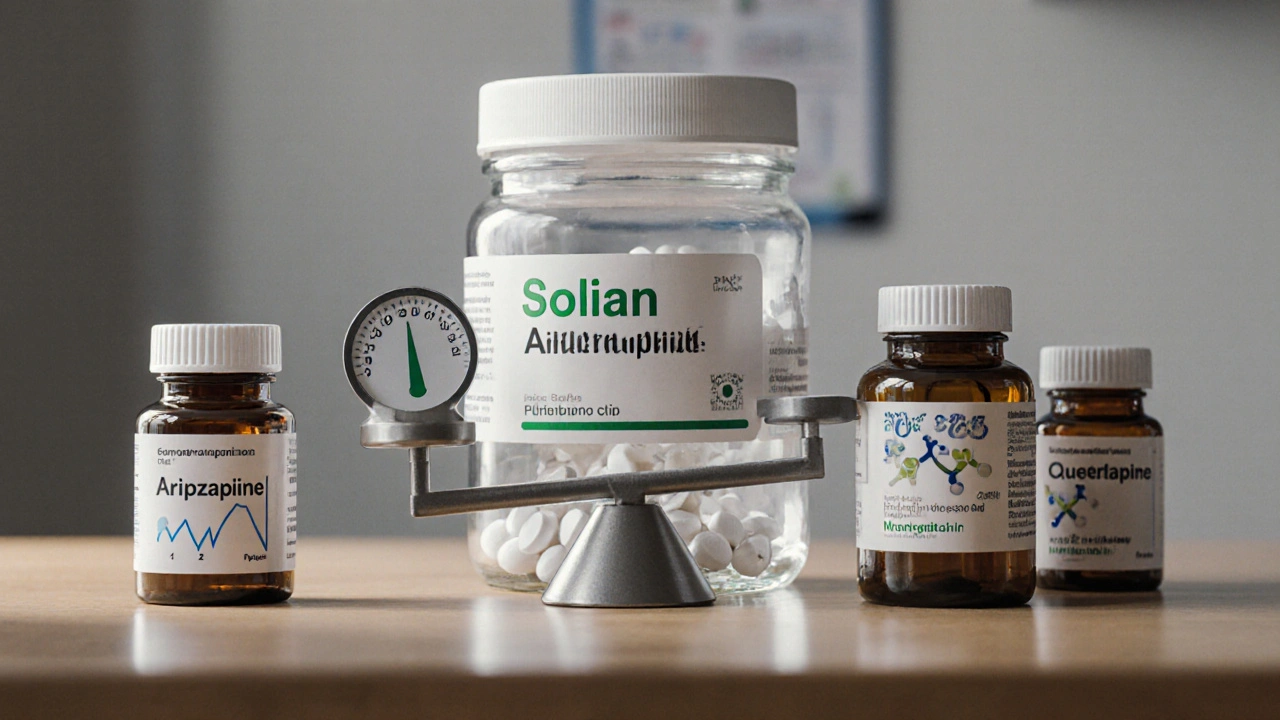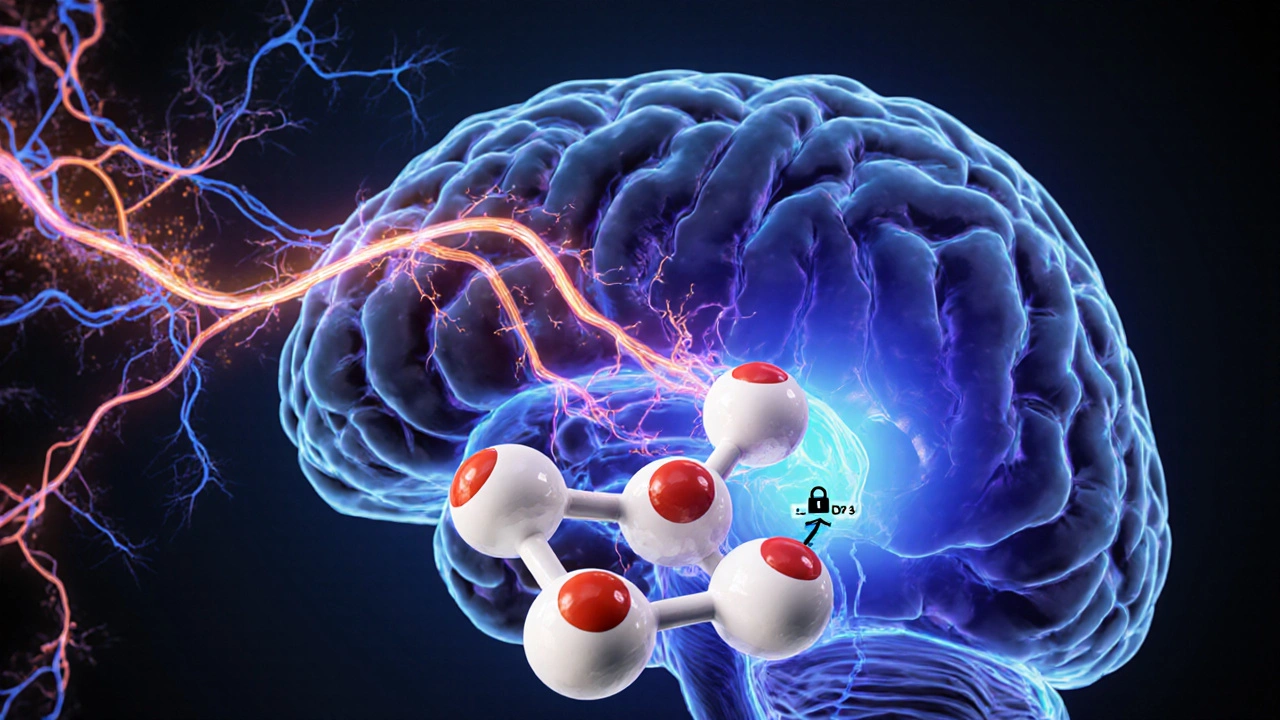Solian (Amisulpride) vs. Other Antipsychotics: In‑Depth Comparison
 Oct, 14 2025
Oct, 14 2025
Quick Takeaways
- Solian ( Amisulpride ) is a selective dopamine D2/D3 antagonist mostly used for schizophrenia and persistent depressive disorder.
- It causes less weight gain than olanzapine but raises prolactin more than aripiprazole.
- Typical daily dose ranges from 200mg to 800mg; low‑dose (50‑150mg) works for dysthymia.
- Side‑effects to watch: hyperprolactinaemia, extrapyramidal symptoms (EPS), and occasional QT‑interval prolongation.
- When choosing an alternative, consider efficacy on positive vs. negative symptoms, metabolic risk, and how the drug is metabolised.
What Is Solian (Amisulpride)?
Amisulpride is a second‑generation antipsychotic marketed in many countries under the brand name Solian. It was first launched in Europe in the 1990s and is approved for treating schizophrenia and, at lower doses, persistent depressive disorder. Unlike many atypicals, amisulpride has a narrow receptor profile - it blocks dopamine D2 and D3 receptors without strong activity at serotonin 5‑HT2A, which explains its distinct side‑effect pattern.
How Amisulpride Works
Amisulpride binds preferentially to the post‑synaptic D2/D3 receptors in the mesolimbic pathway, reducing the over‑activity that underlies hallucinations and delusions. At low doses (50‑150mg), it also blocks presynaptic autoreceptors, enhancing dopamine release and producing an antidepressant effect. Because it does not strongly antagonise serotonin receptors, it tends to cause fewer metabolic issues but can raise prolactin levels through dopamine blockade in the tuberoinfundibular tract.
Key Clinical Profile of Amisulpride
- Typical dosage: 200mg-800mg per day, split into two doses; low‑dose for depression is 50mg-150mg.
- Efficacy: Robust improvement in positive symptoms; modest benefit for negative symptoms.
- Metabolic impact: Minimal weight gain (average +1kg) and low fasting glucose rise.
- Hormonal side‑effects: Prolactin elevation in up to 30% of patients; may cause galactorrhoea or menstrual irregularities.
- Extrapyramidal symptoms: Higher than most atypicals, especially at >600mg/day.
- Cardiac safety: Rare QTc prolongation; baseline ECG recommended for patients with cardiac risk.

Common Alternatives to Amisulpride
Below is a quick snapshot of the most frequently prescribed antipsychotics you might compare with Solian.
Aripiprazole (brand "Abilify") is a dopamine‑partial agonist that works as a stabiliser, offering lower risk of prolactin rise and a modest weight‑gain profile.
Olanzapine (brand "Zyprexa") is a potent serotonin‑5HT2A/D2 antagonist known for high efficacy but notable metabolic side‑effects, especially weight gain and diabetes risk.
Quetiapine (brand "Seroquel") has strong antihistamine activity, making it sedating; it’s often used when insomnia is a major complaint.
Risperidone (brand "Risperdal") provides reliable control of positive symptoms but can raise prolactin at higher doses.
Ziprasidone (brand "Geodon") is a serotonin‑dopamine antagonist with a favourable metabolic profile but requires dosing with food for absorption.
Haloperidol (brand "Haldol") is a first‑generation (typical) antipsychotic; it is very effective for acute psychosis but carries a high EPS risk.
Clozapine is reserved for treatment‑resistant schizophrenia; it excels at reducing suicidal thoughts but demands regular blood monitoring due to agranulocytosis risk.
Side‑by‑Side Comparison
| Drug | Primary Mechanism | Typical Daily Dose | Effect on Positive Symptoms | Weight‑Gain Risk | Prolactin Elevation | EPS (Movement) Risk |
|---|---|---|---|---|---|---|
| Amisulpride | D2/D3 antagonist | 200‑800mg | High | Low | Medium‑High | Medium |
| Aripiprazole | D2 partial agonist | 10‑30mg | Moderate | Low | Low | Low |
| Olanzapine | D2/5‑HT2A antagonist | 5‑20mg | Very High | High | Low‑Medium | Low‑Medium |
| Quetiapine | D2/5‑HT2A antagonist + H1 blockade | 300‑800mg | Moderate | Medium | Low | Low |
| Risperidone | D2/5‑HT2A antagonist | 2‑8mg | High | Low‑Medium | Medium‑High | Medium |
| Ziprasidone | D2/5‑HT2A antagonist | 40‑80mg | Moderate | Low | Low | Low |
| Haloperidol | D2 antagonist (typical) | 5‑20mg | Very High | Low | Low | High |
Which Antipsychotic Fits Your Needs?
- Prioritise metabolic health? Choose aripiprazole, ziprasidone, or amisulpride (low weight gain) over olanzapine.
- Concerned about prolactin? Avoid high‑dose amisulpride and risperidone; aripiprazole has the lowest impact.
- Need rapid control of severe hallucinations? Haloperidol or high‑dose olanzapine work fast, but watch EPS or metabolic side‑effects.
- Managing treatment‑resistant schizophrenia? Clozapine is the gold standard; consider adding low‑dose amisulpride only under specialist supervision.
- Sleep problems are a major issue? Quetiapine’s sedating properties can double‑purpose as a sleep aid.

Practical Checklist for Switching or Starting
- Confirm diagnosis and symptom profile (positive vs. negative symptoms).
- Review current metabolic parameters: weight, fasting glucose, lipid panel.
- Check baseline prolactin level if menstrual or lactation concerns exist.
- Evaluate cardiac history; order ECG for drugs with QT risk (amisulpride, ziprasidone).
- Discuss dosing schedule - most antipsychotics are split twice daily, but some (aripiprazole) can be once‑daily.
- Plan a titration strategy: start low, increase weekly while monitoring side‑effects.
- Schedule follow‑up visits at 2weeks, 6weeks, and 3months to assess efficacy and tolerability.
Frequently Asked Questions
Frequently Asked Questions
Can I take Amisulpride with other psychiatric meds?
Yes, clinicians often combine amisulpride with antidepressants or mood stabilisers, but they monitor for additive side‑effects, especially QT prolongation when paired with other QT‑affecting drugs.
How long does it take to see improvement?
Most patients notice reduced hallucinations and delusions within 1‑2weeks, while negative‑symptom improvement can take 4‑6weeks of steady dosing.
Is weight gain a reason to switch from Olanzapine to Amisulpride?
If a patient gains more than 5% of body weight on olanzapine, many psychiatrists consider switching to amisulpride or aripiprazole because they have a much smaller impact on appetite and metabolism.
Do I need regular blood tests while on Amisulpride?
Baseline prolactin, liver function, and ECG are recommended. After the first month, repeat prolactin if menstrual changes occur, but routine monthly labs are not required unless other risk factors exist.
Can Amisulpride be used in teenagers?
In Europe, amisulpride is approved for patients 12years and older for schizophrenia. In the U.S., it is not FDA‑approved, so clinicians rely on off‑label experience and closely monitor growth and endocrine effects.

Laurie Princiotto
October 14, 2025 AT 19:31I’ve read all the hype about Amisulpride, and honestly it’s overrated 😒. The so‑called “minimal weight gain” claim feels like marketing fluff. If you’re chasing a magic bullet, keep looking.
Justin Atkins
October 16, 2025 AT 21:01Amisulpride’s selective antagonism of post‑synaptic D2/D3 receptors distinguishes it from broader atypicals. By sparing 5‑HT2A blockade, it mitigates the metabolic derangements common to agents such as olanzapine. Pharmacokinetically, it exhibits a half‑life of approximately 12‑20 hours, permitting BID dosing in most regimens. Clinicians often initiate therapy at 50 mg for depressive indications, titrating upward to 200‑800 mg for schizophrenic symptomatology.
June Wx
October 18, 2025 AT 22:31Honestly, the whole Solian hype feels like a boutique fad for the pharma‑elite. If you care about real outcomes, skip the buzz.
kristina b
October 21, 2025 AT 00:01When we scrutinize the pharmacodynamic tapestry of amisulpride, we uncover a paradoxical duality that both enlightens and perplexes the seasoned psychiatrist.
At low dosages, it paradoxically augments dopaminergic transmission via presynaptic autoreceptor blockade, thereby conferring an antidepressant effect seldom appreciated in typical antipsychotic discourse.
Conversely, at therapeutic ranges aimed at psychosis, its robust post‑synaptic D2/D3 antagonism curtails the excess dopaminergic signaling that fuels hallucinations and delusions.
This bifurcated mechanism invites a nuanced titration strategy, one that must be calibrated to the individual’s symptom profile and physiological reserve.
From a metabolic standpoint, amisulpride stands apart; its negligible affinity for 5‑HT2C and H1 receptors translates into a modest impact on appetite and lipid homeostasis.
Nevertheless, the clinician should remain vigilant for hyperprolactinemia, a side‑effect rooted in its tuberoinfundibular D2 blockade, which can precipitate galactorrhea, menstrual irregularities, and sexual dysfunction.
The prevalence of clinically significant prolactin elevation hovers around 30 percent, a figure that warrants routine monitoring, especially in populations vulnerable to endocrine disturbances.
Furthermore, the drug’s propensity for extrapyramidal symptoms, particularly at doses exceeding 600 mg per day, underscores the necessity for periodic assessment of motor function.
Cardiac safety, while generally reassuring, is not without concern; rare cases of QTc prolongation have emerged, prompting baseline and follow‑up electrocardiograms in patients with pre‑existing cardiac risk factors.
In comparative efficacy, amisulpride excels at ameliorating positive symptoms, yet its modest impact on the negative symptom domain suggests adjunctive strategies may be required for comprehensive recovery.
When juxtaposed with olanzapine, the latter’s superior potency in reducing psychotic symptomatology is offset by its notorious metabolic burden, a trade‑off that must be weighed in shared decision‑making.
Aripiprazole, with its partial agonist profile, offers a lower risk of prolactin surge but may insufficiently address severe positive symptoms in certain cohorts.
Clozapine remains the gold standard for treatment‑resistant cases, yet its hematologic toxicity profile mandates rigorous blood count surveillance, a logistical hurdle absent with amisulpride.
Thus, the clinician’s armamentarium benefits from recognizing that amisulpride occupies a middle ground-effective, metabolically benign, yet not devoid of endocrine and motor side‑effects.
In practice, the art lies in tailoring dosing, monitoring, and, when necessary, transitioning to alternative agents to sculpt an individualized therapeutic trajectory that honors both efficacy and tolerability.
Ida Sakina
October 23, 2025 AT 01:31Prescribing amisulpride without regard for its hormonal impact is a dereliction of duty. The elevation of prolactin can disrupt lives, a fact no clinician may ignore. Ethical practice demands that we prioritize patient well‑being above pharmaceutical convenience. Therefore, thorough endocrine monitoring must become standard when this agent is utilized.
Amreesh Tyagi
October 25, 2025 AT 03:01Looks like everyone’s buying into the hype but the side effects are real you’ll end up with more problems than solutions
Brianna Valido
October 27, 2025 AT 03:31Great read! 😊 If you’re looking for a mood‑lifting option with low weight gain, low‑dose amisulpride can be a solid choice. Keep tracking your symptoms and celebrate small wins! 🎉
Caitlin Downing
October 29, 2025 AT 05:01I think it’s super helpful to check prolactin levels every few months, especially if you’re on the higher end of the dose range. Also, don’t forget to ask about any weird stomach feelings – it happens more often than you’d expect. BTW, your table is on point!
Robert Jaskowiak
October 31, 2025 AT 06:31Wow, the US loves its shiny new meds, but did anyone tell you that in Europe they’ve been using Solian for decades? Guess we’re just late to the party, huh?
Julia Gonchar
November 2, 2025 AT 08:01Just a heads‑up: the half‑life of amisulpride can stretch up to 24 hours in patients with hepatic impairment, so dose adjustments are often necessary.
Annie Crumbaugh
November 4, 2025 AT 09:31Monitoring weight is still important even with low‑risk drugs.
Vic Harry
November 6, 2025 AT 11:01America should stick to home‑grown meds not some foreign brand that messes with your hormones
Suman Wagle
November 8, 2025 AT 12:31It’s fascinating how we chase the perfect antipsychotic while ignoring the human element. Sarcasm aside, every molecule has trade‑offs and patients deserve a candid conversation. Encouraging a shared decision process can transform a prescription into a partnership. Remember, the only thing worse than side‑effects is feeling unheard.
Neil Sheppeck
November 10, 2025 AT 14:01Hey folks, if you’re navigating the switch from olanzapine to amisulpride, start low and go slow-maybe 50 mg and titrate by 50 mg every week while watching weight and prolactin. It’s also a good idea to keep the psychiatric team in the loop so everyone’s on the same page. The journey can be smoother when you have a solid support network around you.
Stephanie S
November 12, 2025 AT 15:31Consider, dear colleagues, the importance of baseline laboratory assessments-including prolactin, fasting glucose, and lipid profile-prior to initiating amisulpride; subsequently, schedule follow‑up evaluations at two‑week, six‑week, and three‑month intervals, thereby ensuring early detection of adverse effects; furthermore, educate patients about potential endocrine changes, such as galactorrhea or menstrual irregularities, so that they may report symptoms promptly; finally, maintain meticulous documentation to facilitate interdisciplinary communication and optimal patient outcomes.
Bradley Fenton
November 14, 2025 AT 17:01A quick tip: check ECG before starting amisulpride if the patient has cardiac history. It’s a simple step that can prevent serious issues.
Wayne Corlis
November 16, 2025 AT 18:31So let’s all applaud the pharmaceutical industry for gifting us yet another “miracle” drug that supposedly solves all our dopamine problems while quietly nudging prolactin levels sky‑high. The marketing brochures love to brag about minimal weight gain, yet they conveniently omit the fact that a third of patients experience uncomfortable hormonal side‑effects. Of course, the clinical trials were conducted on perfectly healthy volunteers, not the real‑world patients juggling comorbidities. Meanwhile, prescribers are left to decipher dense tables and hope they didn’t miss a contraindication. It would be fantastic if we could get a side‑effect‑free option, but until then, diligent monitoring remains our only salvation. So, congratulations, we have another tool in the toolbox-just remember to grease the hinges with lab work.